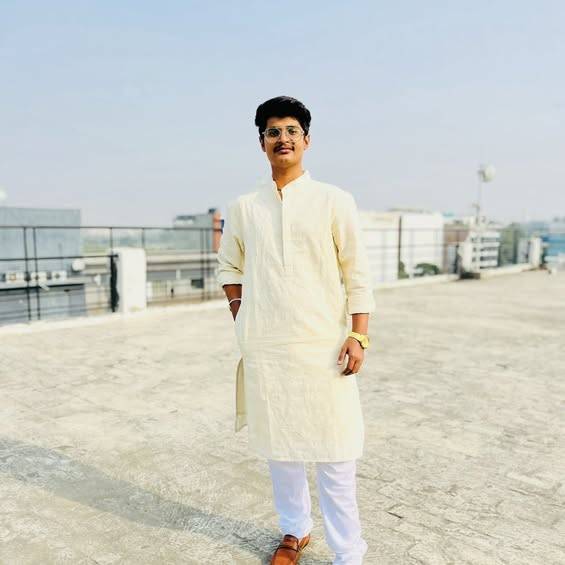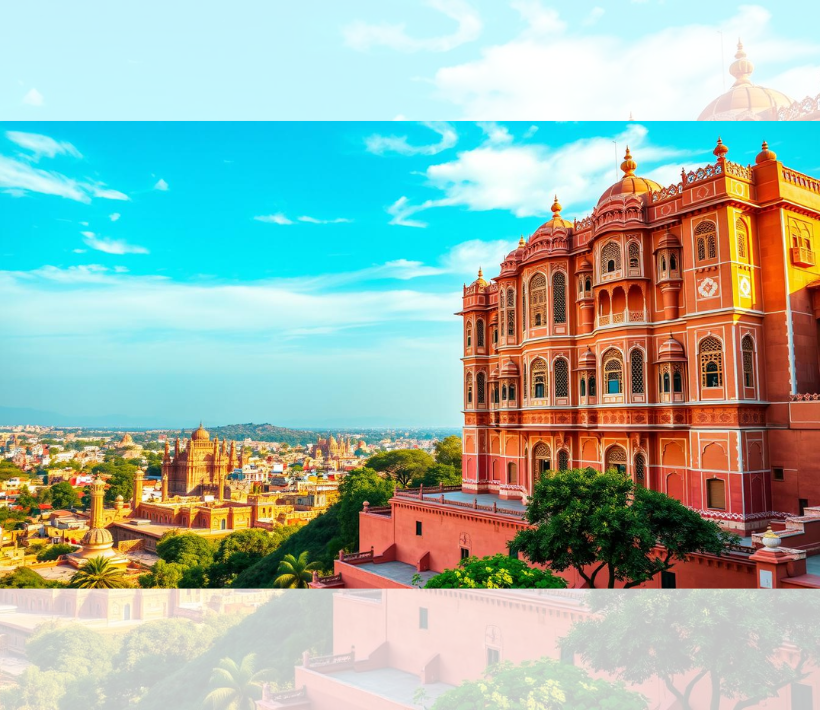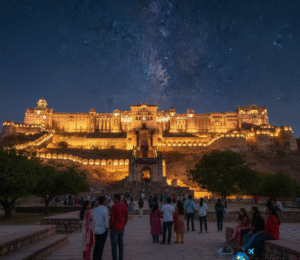Jaipur’s Hawa Mahal: A Breathtaking Architectural Gem
As you wander through the vibrant streets of Pink City, Jaipur, you’re in for a treat with the breathtaking Hawa Mahal, a stunning architectural gem that showcases the rich cultural heritage of Rajasthan tourism.

Traveling with Raghav Ahuja, you’ll discover the magnificence of this iconic landmark, setting the stage for a deeper dive into its history, architecture, and visitor experience. You’ll be drawn into the world of royal palaces and historical monuments that make Jaipur tourism a must-visit destination.
Key Takeaways
- Discover the rich history and cultural significance of Hawa Mahal
- Explore the architectural marvels of Rajasthan tourism
- Experience the vibrant culture of Pink City, Jaipur
- Learn about the must-visit destinations in Jaipur for sightseeing
- Uncover the secrets of Indian landmarks that make Jaipur tourism unique
The Magnificent Jaipur – Hawa Mahal: An Overview
As you step into the heart of Jaipur, the majestic Hawa Mahal stands before you, a testament to the city’s rich architectural heritage. This magnificent monument, known as the Palace of Winds, is a blend of Rajput and Mughal architectural styles, reflecting the cultural richness of Rajasthan.

The Palace of Winds: First Impressions
Your first encounter with Hawa Mahal is sure to leave a lasting impression. The monument’s intricate pink sandstone façade and unique architecture make it a standout landmark in Jaipur. With its 953 small windows, or jharokhas, Hawa Mahal was designed to allow the royal ladies to observe everyday life in the street below without being seen.
Significance in Rajasthan’s Cultural Heritage
Hawa Mahal is not just an architectural marvel; it is a significant part of Rajasthan’s cultural heritage. Built in 1799 by Maharaja Sawai Pratap Singh, it symbolizes the rich history and traditions of the region. The monument is a reflection of the Rajput and Mughal influences that have shaped the cultural identity of Rajasthan.
| Aspect | Description | Significance |
|---|---|---|
| Architecture | Blend of Rajput and Mughal styles | Reflects cultural diversity |
| Historical Importance | Built in 1799 by Maharaja Sawai Pratap Singh | Symbol of rich history |
| Cultural Impact | Part of Rajasthan’s heritage | Represents regional traditions |
Historical Journey of Hawa Mahal
You are about to embark on a historical journey through the construction of Hawa Mahal, a monument that has become synonymous with Jaipur. As you delve into its history, you’ll understand the significance of this structure in the context of Rajasthan’s rich cultural heritage.

The Royal Vision Behind the Construction
Hawa Mahal was constructed in 1799 by Maharaja Sawai Pratap Singh, a ruler of the Jaipur kingdom. The maharaja was inspired by the Khetri Mahal in Jhunjhunu, Rajasthan, and wanted a similar structure in Jaipur. The construction was overseen by Lal Chand Usta, a renowned architect of the time. The royal vision behind Hawa Mahal was not only to create a beautiful monument but also to provide a cool respite for the royal family during the hot summer months.
The design of Hawa Mahal is a blend of Rajput and Mughal architectural styles, reflecting the cultural diversity of the region. The palace was built using red and pink sandstone, materials that were readily available and symbolized the grandeur of the kingdom.
Evolution Through the Centuries
Over the centuries, Hawa Mahal has undergone several restorations and renovations. The monument has been maintained by the Archaeological Survey of India (ASI), ensuring its structural integrity and historical significance are preserved. Despite the challenges posed by time and environmental factors, Hawa Mahal remains a testament to the architectural prowess of its creators.
| Year | Event | Significance |
|---|---|---|
| 1799 | Construction of Hawa Mahal | Commissioned by Maharaja Sawai Pratap Singh |
| 19th Century | Renovations | Maintenance by successive rulers |
| 20th Century | Protection by ASI | Preservation of historical integrity |
Connection to Jaipur’s Pink City Identity
Hawa Mahal is an integral part of Jaipur’s identity as the Pink City. The monument’s architecture, with its distinctive pink sandstone façade, complements the city’s aesthetic. The structure is not just a historical monument but a symbol of Jaipur’s rich cultural heritage, attracting visitors from around the world.
As you explore Hawa Mahal, you’re not just visiting a historical site; you’re experiencing the essence of Jaipur’s architectural and cultural legacy. The monument stands as a reminder of the city’s glorious past and its continued relevance in the present.
Architectural Marvel: Design and Structure
The majestic Hawa Mahal stands as a pinnacle of architectural innovation in Jaipur. As you delve into its design and structure, you’ll uncover the intricacies that make this monument a breathtaking spectacle. Hawa Mahal’s architecture is a blend of Rajput and Mughal styles, reflecting the cultural richness of Rajasthan.

The Iconic Pink Sandstone Façade
The façade of Hawa Mahal is its most striking feature, made from pink sandstone that gives the monument its distinctive color. This iconic façade is not just aesthetically pleasing; it’s also a marvel of engineering, with intricate carvings and delicate latticework that filters the sunlight, creating a serene ambiance. The use of pink sandstone was a deliberate choice, symbolizing the royal heritage of Jaipur.
The 953 Jharokhas: Purpose and Symbolism
One of the most fascinating aspects of Hawa Mahal is its 953 jharokhas, or windows, which are designed to allow the royal ladies to observe street life without being seen. These jharokhas are not just functional; they are also symbolic, representing the blend of privacy and community that was a hallmark of royal life in Jaipur. The intricate design of the jharokhas adds to the overall architectural beauty of Hawa Mahal.
Interior Layout and Hidden Chambers
Beyond its stunning façade, Hawa Mahal’s interior layout is equally intriguing, with a series of interconnected chambers and corridors. The interior design was focused on maintaining a cool temperature, even during the peak summer months, thanks to the clever use of ventilation and shading. While the interior is less ornate than the exterior, it holds its own charm, with subtle architectural details that reflect the ingenuity of its designers.
As you explore Hawa Mahal, you’ll gain a deeper appreciation for the architectural marvel that it represents. From its iconic pink sandstone façade to its intricate jharokhas and clever interior design, Hawa Mahal is a testament to the rich cultural heritage of Jaipur.
Visitor Experience: What to Expect
As you plan your visit to Hawa Mahal, it’s essential to know what to expect to make the most of your trip. The entrance fee for Hawa Mahal is nominal, making it an affordable destination for tourists. The best time to visit Hawa Mahal is during the early morning or late evening when the weather is pleasant, and the monument is less crowded.
When visiting Hawa Mahal, you can explore the intricate architecture and design of the monument. The 953 jharokhas, or windows, are a highlight of the structure, providing a unique glimpse into the royal history of Jaipur. As part of Jaipur tourism, Hawa Mahal is a must-visit attraction, offering a glimpse into the city’s rich cultural heritage.
To ensure a smooth and enjoyable visit, consider using a travel guide or joining a guided tour. This will help you navigate the monument and gain a deeper understanding of its history and significance. With its stunning architecture and rich history, Hawa Mahal is a must-visit destination for anyone traveling to Jaipur.
FAQ
What is the entrance fee to visit Hawa Mahal in Jaipur?
The entrance fee to visit Hawa Mahal varies for Indians and foreigners. It’s best to check the latest information on the official Rajasthan tourism website or at the ticket counter.
What is the best time to visit Hawa Mahal?
The best time to visit Hawa Mahal is early morning or late afternoon when the weather is pleasant, and the sunlight enhances the beauty of the monument.
Can I take guided tours of Hawa Mahal?
Yes, guided tours are available at Hawa Mahal, providing insights into its history, architecture, and cultural significance.
Is Hawa Mahal a part of the Jaipur city tour?
Yes, Hawa Mahal is one of the top attractions in Jaipur and is often included in the city’s sightseeing tours.
What are the nearby attractions to Hawa Mahal?
Nearby attractions include the City Palace, Jantar Mantar, and Johari Bazaar, making it a great starting point for exploring Jaipur.
Is Hawa Mahal accessible for visitors with disabilities?
Hawa Mahal’s architecture and layout may present challenges for visitors with disabilities. It’s advisable to check ahead of time for any specific accommodations or restrictions.
Can I capture photographs inside Hawa Mahal?
Photography is usually allowed, but it’s always a good idea to check with the authorities for any specific rules or restrictions on photography inside the monument.

Hi, I am Raghav Ahuja a curious explorer, travel enthusiast, and the voice behind Travel The World Today. I believe in discovering the beauty of every destination without breaking the bank. Through my journeys, I share tips, stories, and travel guides to help you explore the world on a budget. Whether you’re a solo adventurer, a family traveler, or just planning your next escape, I’m here to inspire and guide you every step of the way.







Post Comment